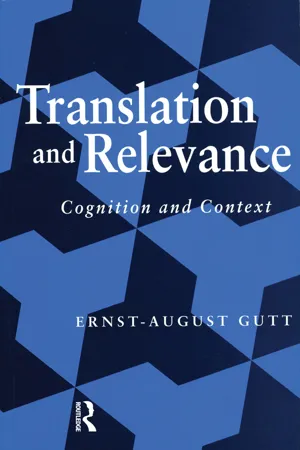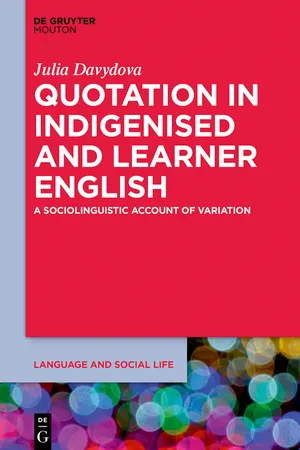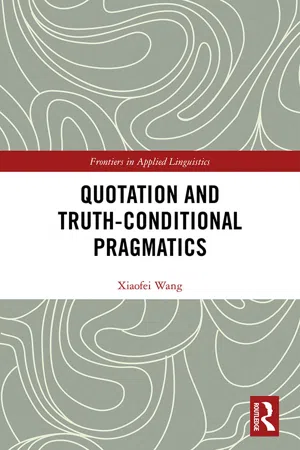Languages & Linguistics
Direct Quote
A direct quote is a word-for-word reproduction of a spoken or written statement. It is enclosed in quotation marks and attributed to the original source. Direct quotes are used to provide evidence, support arguments, or convey the exact wording of a source. In academic writing, they are often cited to give credit to the original author.
Written by Perlego with AI-assistance
5 Key excerpts on "Direct Quote"
Learn about this page
Index pages curate the most relevant extracts from our library of academic textbooks. They’ve been created using an in-house natural language model (NLM), each adding context and meaning to key research topics.
- eBook - ePub
A Narrative Community
Voices of Israeli Backpackers
- Chaim Noy(Author)
- 2006(Publication Date)
- Wayne State University Press(Publisher)
With the acknowledgment of the intertextual role played by quotations in the stories, I also acknowledged that these possessed tight communal characteristics and were organically interembedded within a community of voices and stories. Thus, I emerged from the research hearing the members of the narrative community with an auditory and even acoustic impression: that of fleeting quotations and multiple ventriloquism. Over and above the intertextual role they played and the shared (communal) voices they introduced into the narratives, quotations helped instantiate a performative context. Hence, beyond their referential contribution (quotations of . . .), they were highly meaningful in and of themselves.Quotation, or “direct reported speech” (DRS, oratio recta, also called direct speech/quotations/discourse), is defined as an utterance that “evokes the original speech situation and conveys, or claims to convey, the exact words of the original speaker in direct discourse” (Florian Coulmas, cited in Holt 1996, 222). Conventionally, it “represents an exact reproduction of a verbal communication” (Banfield 1973, 30), a case in which the “reporting utterance purportedly represents a speaker’s exact words” (Lucy 1993b, 13). It is a linguistic performance with which all competent speakers of all natural human languages are familiar, wherein there appears to be an “original” utterance that was initially uttered in a different context from the here-and-now and is currently being quoted into an ongoing conversation. What is “direct” about this particular type of direct reported speech is its supposed exactness: purportedly a clear case of discursive mimesis.Although there is general agreement on the formal definition of quotation, there is some divergence in perspective and terminology. For one, the mere convergence of “direct,” which indexes exactness, with “report,” which indexes mediation, is oxymoronic.In any case, the formal components of a quotation performance include: 1. the alleged original discursive event wherein the quoted utterance was initially presented and from which it is quoted2. an utterance—a quotative—that is currently being reported and is framed as conveying the exact word-by-word order of the original occasion. The quoted utterance retains the (personal, spatial, and temporal) deixis of the supposed original context, thus retaining the original perspective3. an animator to whom the utterance is attributed in the original context, and who is usually the original author of the utterance - eBook - ePub
Translation and Relevance
Cognition and Context
- Ernst-August Gutt(Author)
- 2014(Publication Date)
- Routledge(Publisher)
22 Mossop (1987) uses the difference between direct and indirect speech quotations, in his terms “direct-discourse reports” versus “indirect-discourse reports” to differentiate “standard-form translation” from other, freer kinds of translation; for Mossop the essential similarity between “direct-discourse reports” and “standard-form translation” is that “standard-form written translations are like directly reported discourse as regards viewpoint’ (1987:9, italics as in original). He explains: “The meaning of the word ‘I’ in a translation is important, and in standard-form translation, ‘I’ is a stand-in for the source text narrator; ‘I’ is not the translator” (1987:18, italics as in original). Our relevance-theoretic account of direct translation naturally keeps the ‘viewpoint’ of the original and preserves other features in addition.One of the first issues to discuss here is, of course, what direct speech quotations are. It seems that the notion of direct speech quotation can be derived from the nature of stimuli used in communication; in relevance theory such stimuli are defined as follows:A stimulus is a phenomenon designed to achieve cognitive effects. (Sperber and Wilson 1986a :153)Now phenomena here are understood to be “perceptible objects or events” (Sperber and Wilson 1986a :40), and they achieve the desired cognitive effects in virtue of the properties they have.This means, then, that stimuli can be looked at from two different points of view. They can be looked at from the point of view of the cognitive effects they have — for example, what explicatures and/or implicatures they convey — but they can also be looked at from the point of view of the intrinsic properties they have as phenomena, and this is the perspective that seems to be relevant to direct quotation, for, as Wilson and Sperber (1988a) - eBook - ePub
Quotation in Indigenised and Learner English
A Sociolinguistic Account of Variation
- Julia Davydova(Author)
- 2019(Publication Date)
- De Gruyter Mouton(Publisher)
be like worldwide, while highlighting the theory of grammaticalisation (Ferrara and Bell 1995) as a useful diagnostic measuring the level of the variant’s diffusion in each speech community.3.1Quotation: Definition and some theoretical preliminaries
In this study, I have adopted the following definition of quotation. ‘Quotation’ is a discourse-pragmatic strategy used to construct dialogue through reporting someone’s speech, including code-switched material, as well as thoughts, emotions and attitudes, including gestures and non-lexicalised speech sounds (Davydova and Buchstaller 2015: 441). It is closely associated with narration, although it occurs in other genres as well. Native speakers employ this narrative device routinely and frequently to captivate listeners’ attention and render their portrayal of events more vivid and even dramatic. In so doing, they essentially hope to “heighten the performance values of their stories” (Ferrara and Bell 1995: 265). In other words, quotation is a substantially sophisticated means to express evidentiality (Clift 2006; Romaine and Lange 1991). As such, quotation is an integral part of the quotative frame or template, a clause-level structural element. First proposed in Buchstaller (2014: 17) and elaborated on in Buchstaller (2015), the quotative template is illustrated in Figure 2 for convenience.At the most abstract level, the quotative frame consists of the following syntactic strings:NOUNPHRASE+COPULAVERB/VERBUMDICENDI+ (DISCOURSEMARKER)+QUOTE.Because mainstream English is a non-pro-drop variety, the 3.1 slots representing the general categoryNOUNPHRASEare typically filled with lexical material performing the function of the grammatical subject in various L1 vernaculars. The same is true of the structural stringCOPULAVERBS/VERBUMDICENDI,which can collectively be called Predication. The slot can be either realised as an actual copula verb such as be , or alternatively, it can be filled with various verba dicendi , notably say and think . Note that the realisation of a discourse marker is optional. The quote is a focal point of the quotative template. It is conceptually complete without the main clause containing the quotative marker. In other words, it is semantically and syntactically independent of the main clause. In contrast, the main clause introducing the quote is incomplete both semantically and syntactically without the quoted material. This might explain why we frequently encounter zero quotative markers (see example in (19)) in natural speech but not zero quotes. It is thus quite possible to encounter an utterance of the type, e.g. and he was standing there and ø, ‘What a joy! ’ but an utterance of the type, e.g. */? he said - eBook - ePub
- Xiaofei Wang(Author)
- 2017(Publication Date)
- Routledge(Publisher)
Another way to sort out the various manifestations of quotation is pragmatic, contextual, or inference-based. In terms of the purpose a quotation normally serves, one can differentiate between pure quotation, direct quotation, and scare quote. Pure quotation is usually used to make a point about the orthographical, phonetical, and grammatical features of a linguistic sequence; direct quotation is used to report someone’s words, which is typically instantiated as a sentence; scare quote is used to distance the utterer herself from an expression that is usually attributed to someone other than the speaker. One example is that Gómez-Torrente (2003) distinguished pure quotations from impure ones by virtue of the quotation marks being used for referential purposes. Another is De Brabanter’s (2003) typology of quotation which is essentially interpreter-oriented.These two criteria have been widely adopted in literature. Theoretically speaking, all quotations can be characterized on both criteria. They weave together to define what a quotation is. This is observed by Semino and Short (2004) when they said, “Generally speaking, decisions in each individual case involve (i) formal and (ii) contextual and pragmatic criteria, but not necessarily in the same proportions” (p. 224). In practice, these two criteria can also be integrated in the categorization of quotation as well. This underlies Recanati’s typology of quotation, as I understand it. Recanati is a practitioner of this approach as he acknowledges a syntax-based criterion to distinguish open quotation from closed quotation; meanwhile, he also resorts to a semantic criterion to break hybrid quotations into cumulative and non-cumulative kinds. I will elucidate his view in detail below.5.3.2 Singular-term theses
Recanati (2001b) classified quotations into closed and open types, depending on whether they are linguistically recruited as a singular term or not. This linguistic recruitment criterion is obviously a syntax-based one. It is further represented by an argument of what I call “the singular-term thesis 1,” which goes like this: - eBook - ePub
- Roger D. Sell(Author)
- 2014(Publication Date)
- Routledge(Publisher)
Halliday (1985 : 228ff.) to mention only two works of a generally high order.)Nor is poetics, which has investigated the field longest (starting from Plato) and on the whole best, an exception to the rule. Gérard Genette, for example, opposes the pure mimesis of directness, with its ‘literal fidelity’ and ‘documentary autonomy’, to the diegesis of indirectness: ‘It is, so to speak, acknowledged in advance that the narrator is not satisfied with transposing the words into subordinate clauses, but that he condenses them, integrates them into his own speech, and thus expresses them in his own style’ (Genette 1980 : 172).Despite the impressive ancestry and coalition behind it, however, this article of faith is nothing but a scholar’s myth, an ivory tower delusion. It has no leg to stand on either in logic or in culture or in reality, and what is more, nor in direct or indirect discourse. With regard to directness, I have traced the fallacy and suggested a counter-theory in a series of essays (Sternberg 1977 , 1978 , 1982a , 1982b ). To put the thing in a nutshell, the direct form cannot reproduce even where it (or we) would, because a number of original objects and aspects are unreproducible: from the context of utterance through the turns of thought to the intonation of speech. Nor would it be reasonable to expect the reproduction of objects that do not, may not, or will not exist, as in modalized direct quotation: prospective (‘I will tell him: “…”’), imperative (‘Tell him: “…”’), hypothetical (‘If I tell/told/had told him: “…”’), etc. Again, discourse provides an entire set of anti-reproductive licenses and conventions, such as translational mimesis, whereby Midianites (for example) speak pure Biblical Hebrew, or interpretative paraphrase within quotes, or even intersemiotic transfer from non-verbal to verbal expression (‘His eyes said: “Thanks”’). And life makes its own laws and loopholes, notably the faults of memory. Under such pressures from all quarters, there is no way to maintain the bond between direct quotation and literal representation. Positively speaking, it turns out that: (1) the direct form is potentially the best reproducer within a system not much concerned with reproduction per se




